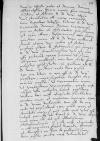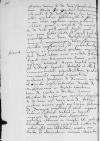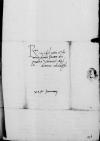List #2026
Stanisław HOZJUSZ (HOSIUS) do Ioannes DANTISCUSs.l., [1539, beginning of January]
| odebrano [1539]-01-19 Rękopiśmienne podstawy źródłowe:
Publikacje:
| ||||||
Tekst + aparat krytyczny + komentarzZwykły tekstTekst + komentarzTekst + aparat krytyczny
Reverendissimo in Christo Patri et Domino, domino
Reverendissime in Christo Pater et domine, domine observatissime.
Precor annum hunc ineuntem faustum et felicem Reverendissimae Dominationi Vestrae atque una servitutem illi meam commendo.
Cum legendas dedissem cf.
Ego me totum in aere esse Reverendissimae Dominationi Vestrae profiteor, cuius singulari beneficio fore prorsus confido, ut canonicatum meum, ut praebendam Varmiensem quiete mihi absque ulla molestia liceat possidere. Vellem dari mihi aliquando facultatem gratum meum et memorem animum erga Reverendissimam Dominationem Vestram declarandi. Hoc sibi de me certo ut persuadeat rogo, quod opera et servitute mea, si quis modo eius usus esse potest, perinde uti liceat Reverendissimae Dominationi Vestrae atque eius, quem sibi scit esse addictissimum fidelissimumque. Si quid mihi aliquando oneris imponere fuerit dignata, honoris et beneficii written over o⌈oii written over o⌉ in loco id positurus sum, dum possim gratae meae voluntatis  BCz 1618, p. 928 aliquam tamen Reverendissimae Dominationi Vestrae significationem dare.
BCz 1618, p. 928 aliquam tamen Reverendissimae Dominationi Vestrae significationem dare.
Quae hic agantur, supervacaneum esse puto Reverendissimae Dominationi Vestrae scribere, cum vivam istic epistulam habitura sit, dominum  BCz 1618, p. 929 res est, quemadmodum unus tot laboribus sufficere possit.
S(erenissima) or S(acra)⌈S(erenissima)S(erenissima) or S(acra)⌉
maiestas regia multum afficitur dotibus eius tot tam praeclaris. Placet sibi, quod virum talem habeat. Cupit eum esse cancellarium, sed non desunt, qui adversentur modis omnibus. Nihil ei maiori est impedimento quam dignitas, quam virtus, quam probitas, quae tamen olim adiumento esse solebant. Ego sum adhuc in optima spe. Sed si ea me, quod Deus omen obruat, feffellerit, celerius opinione omnium me Varmia videbit. Haec ego liberius scribo Reverendissimae Dominationi Vestrae, et certe soli illi scripta velim, ne si quid emanaret, fraudi mihi esse posset. Cetera explicabit latius Reverendissimae Dominationi Vestrae dominus Fabianus.
BCz 1618, p. 929 res est, quemadmodum unus tot laboribus sufficere possit.
S(erenissima) or S(acra)⌈S(erenissima)S(erenissima) or S(acra)⌉
maiestas regia multum afficitur dotibus eius tot tam praeclaris. Placet sibi, quod virum talem habeat. Cupit eum esse cancellarium, sed non desunt, qui adversentur modis omnibus. Nihil ei maiori est impedimento quam dignitas, quam virtus, quam probitas, quae tamen olim adiumento esse solebant. Ego sum adhuc in optima spe. Sed si ea me, quod Deus omen obruat, feffellerit, celerius opinione omnium me Varmia videbit. Haec ego liberius scribo Reverendissimae Dominationi Vestrae, et certe soli illi scripta velim, ne si quid emanaret, fraudi mihi esse posset. Cetera explicabit latius Reverendissimae Dominationi Vestrae dominus Fabianus.
Deum precor, ut anni huius exortum Reverendissimae Dominationis Vestrae felicem esse velit. Cuius me gratiae commendo.
Reverendissimae Dominationis Vestrae servus addictissimus



